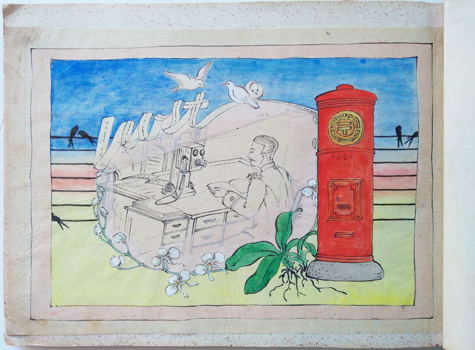
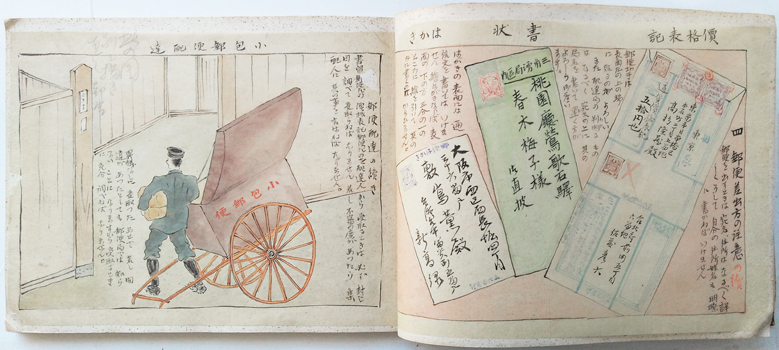
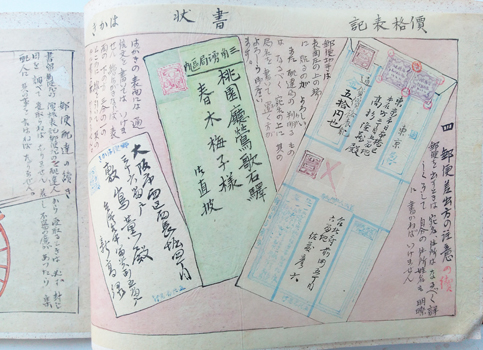
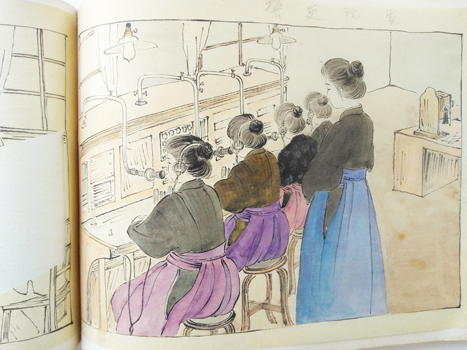

Communications - Japan. Post. A handmade (draft? mock up?) picture book or sketches for paintings on telecommunication and post in Meiji Japan; with "Post" scrolled across what passes for the title page. n.p. c1900 to 1906. 21x29cm patterned wrapper; 27 full page ink drawings (18 coloured) and three pages of text, mostly on translucent drawing paper, mounted on 15 double leaves. Album paper and some drawings spotted. The figure on the title was cut from a drawing of women operators near the end; a figure in another drawing has been redrawn and overlaid on the original; captions sometimes in ink, sometimes in pencil and sometimes not there; drawings of the telegram boys and the women operators exist as ink and as coloured drawings; all signs of work in progress Au$3000
Something of a marvel and mystery. Two of the drawings are signed Asahi but I find no other clue to who made this and why: was it a commission by the Ministry of Communications for a picture book? an exhibition? for a publisher? Our artist has been given access to the inner workings of the service so this is not the fancy of an idle amateur. Tejima Asahi (or Kyokko depending on the reading) has been suggested as the artist but since I can find nothing more than his date of birth it doesn't help me much. And I'm not sure it matters much.
Shibata Shinsai produced a similar series of paintings drawn from life showing the workings of the post office in 1884 that were exhibited at the New Orleans World Fair. Now, here, we have new uniforms, bicycles, telegrams and telephones to celebrate. Which makes the date more definite than the artist: bicycles for telegram boys were introduced in 1892 and in 1906 red was gazetted as their official colour; public telephone boxes appeared in 1900.
I don't believe a finished book or an exhibition of finished paintings from our album appeared. Shibata's paintings are a singular treasure of the Postal Museum, reproduced on the covers of their journal, where a lot of time and effort has gone into the study of their collection of paintings, prints and advertisements that show anything of the postal service. I was struck by just how ubiquitous telegram boys, postmen and parcel deliverers are in scenes of busy Meiji life and how many letter boxes and telegraph poles feature in the symbolic frames within frames of popular prints. It's unthinkable that anything like this album would be ignored and nothing else like this seem to exist.
The drawings are variable in finish and finesse - until we come to the young women telephone operators where the lines are fluid and confident. Was it because our artist had still models to capture? because he had more time? or because he enjoyed drawing women much more than men?
I read somewhere that women did not work nightshifts on the switchboards until complaints about the rudeness and unhelpfulness of male operators saw them banished altogether.
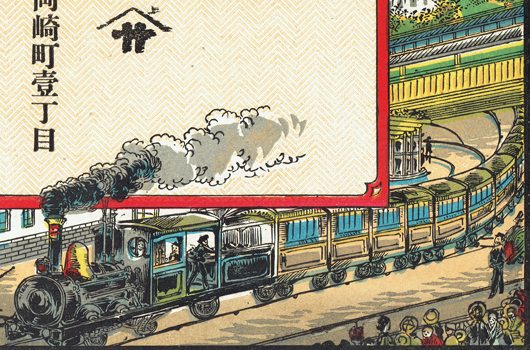
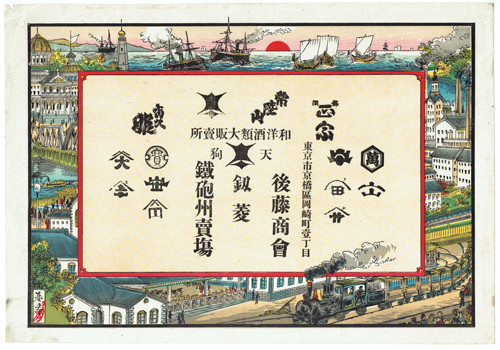
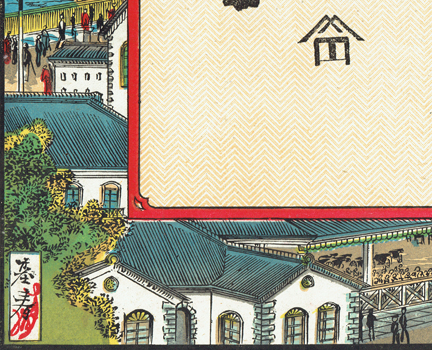
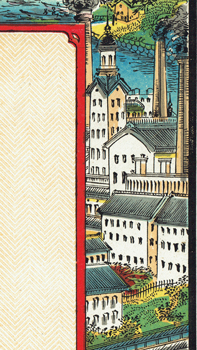

Hikifuda. [Goto Shokai]. n.p. [c1900] 26x38cm colour woodcut. Small knick from a top corner; a nice copy. Au$135
Bustling modern Japan is celebrated in this advertisement for the Japanese and western liquor merchants Goto Shokai. I presume it's the trademarks of the brands they handle that are displayed.
These hikifuda - small posters or handbills - were usually produced with the text panel blank. The customer, usually a retailer, had their own details over printed, so the same image might sell fine silk or soy sauce.
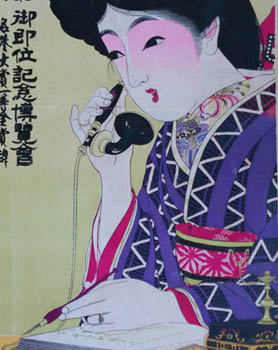
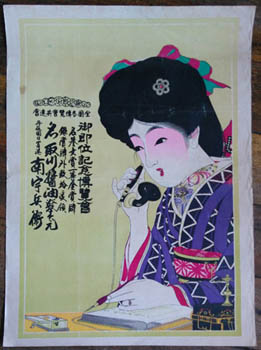

Hikifuda. [Natori-gawa Shoyu Hatsubai-Moto]. n.p. [190-?]. Colour lithograph 52x39cm. A bit creased or rumpled with a couple of closed marginal tears; a pretty good copy. Au$250
I presumed this exquisite modern young woman was advertising kimono silk and perhaps she does in other examples of this advertising handbill cum poster. These things were usually produced with a blank space for a business to print, sometimes write in, their products and details. Here, she is advertising a Natori-gawa soy sauce distributor. Natori-gawa is the river near Sendai in north east Honshu.
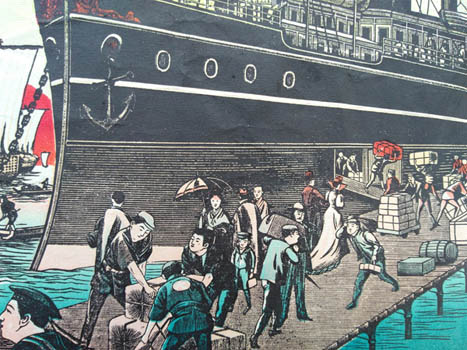
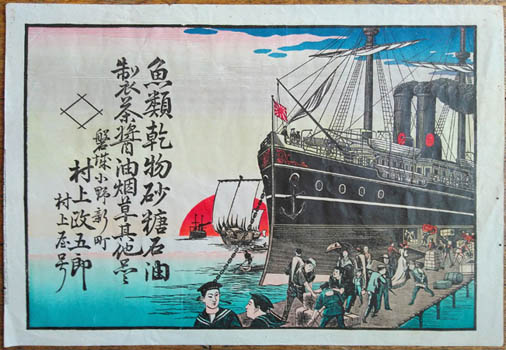

Specimen Hikifuda. ? [Yorozu to Kanbutsu Sato Sekiyu ...] n.p. [c1900?]. Colour woodcut 26x38cm. Rumpled with a couple of small repairs to the edges; quite decent. Stab holes in the right margin showing it was once in an album. Au$200
A bustling handsome print produced for merchants of imported goods. These hikifuda - small posters or handbills - were usually produced with the text panel blank. The customer had their own details over printed. In some cases, like this, samples were were produced with generic text to show the finished product.
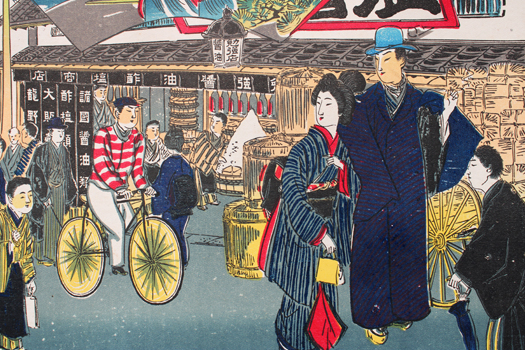
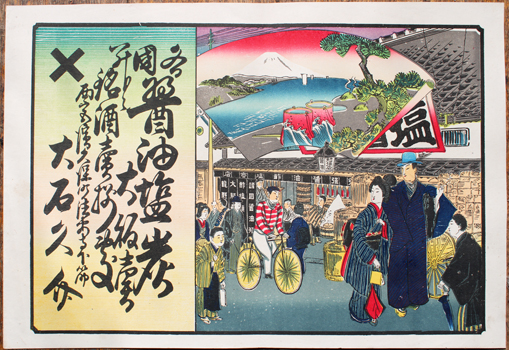
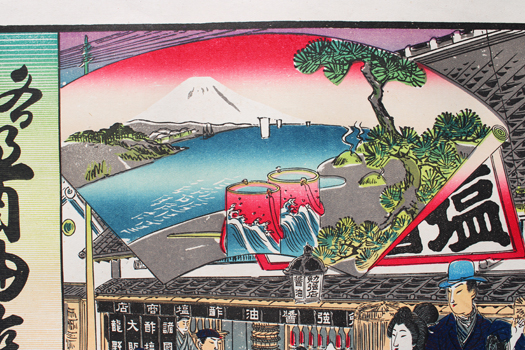

Hikifuda. ... [Shoyu Shio Sumi ...] np [190-?]. Colour lithograph 25x37cm. Pretty good. Au$150
An almost average street scene in late Meiji Japan but: without the telegraph poles and power lines, bowler hats and cyclist it could be a street scene generations earlier.
Hikifuda - small posters or handbills often handed out as seasonal gifts - were usually produced with the text panel blank. The customer, usually a retailer, had their own details over printed, so the same image might sell fine silk or soy sauce. This one, from a Nishinomiya (between Osaka and Kobe) dealer, indeed sells soy sauce, salt, sake and charcoal - tradition kept alive in the modern world.
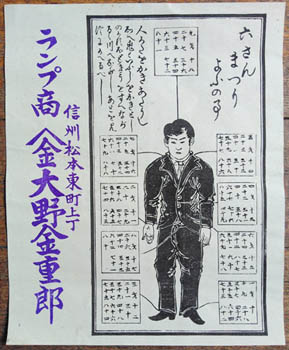
Hikifuda. [Shinshu Matsumoto Higashimachi Uetei]. n.p. [c1900?]. Woodcut broadside 28x24cm. A nice copy. Au$100
An intriguing and to me mysterious handbill from Matsumoto - a city in the Nagano prefecture in central Honshu. It seems clear it offers - in some rustic, or perhaps reverse way - what the well dressed man needs. Superior quality is promised but I'm stumped by all those series of numbers. They don't make sense as measurements to me.
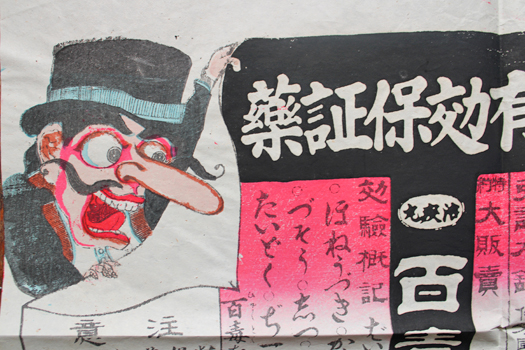
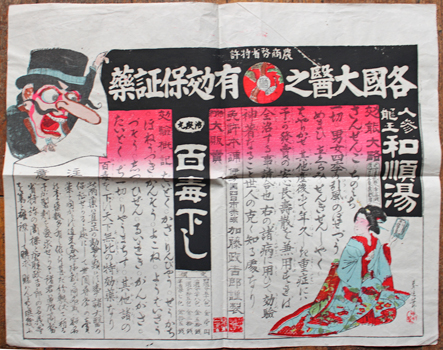
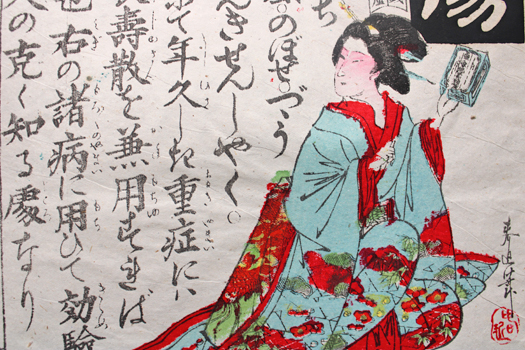

Hikifuda : : Kakkoku taii no yuko hosho-yaku? Hyakudokukudashi : Wajanyu]. c1900? 40x50cm colour woodcut. Au$150
A singular and baffling, to me, handbill or hikifuda for a patent medicine for women that expelled a hundred poisons and cured ailments that any woman was likely to suffer.
It's the villain in the corner that stumps me. Since I can't read the text I have no idea who he is nor what he is doing. My first guess is that he is threatening to tie the young woman to the railroad tracks but I'm sure this predates any American film serials that could have arrived in Japan. So is he a traditional stage villain or does he do something else in Japan? Surely he isn't one of the many great foreign doctors who guarantee Wajanyu or Heshun Tang, which seems to be a traditional Chinese medicine. But ... he is ordering her and us to pay attention.
According to Ernest Clement, in a 1907 article on medical folk-lore in Transactions of the Asiatic Society of Japan, in 1896, in Tokyo alone, there were 1401 registered inventors of patent medicines, 5145 vendors, 42,533 quack doctors and 5137 qualified medicos.
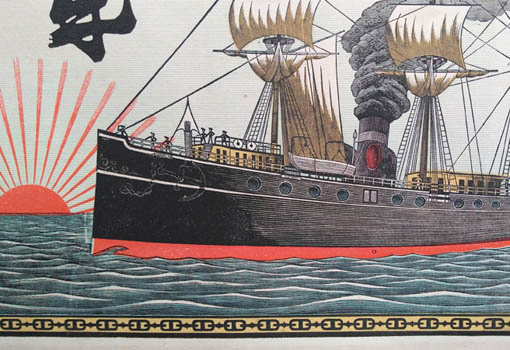
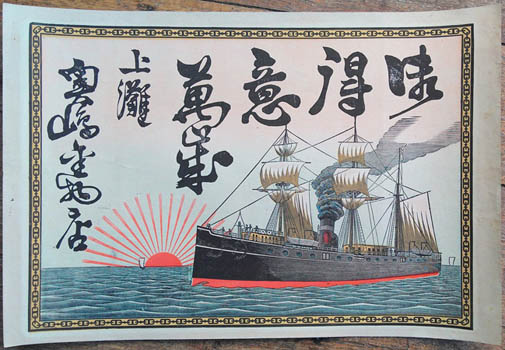

Hikifuda. Hikifuda of a ship against the rising sun. n.p. [c1900?]. Colour wood engraving? 26x36cm. Minor signs of use, quite good. Au$200
This handsome ship hikifuda - small poster or handbill - advertises something I can't read. It uses the western technique of wood engraving, a technique that had a brief run in commercial printing between traditional woodcuts and lithography.
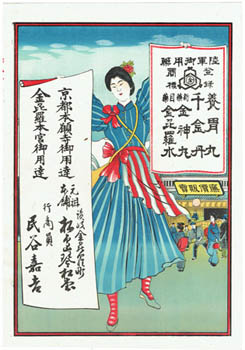
Specimen Hikifuda. A large hikifuda - handbill - or modest poster for Kyoto haberdashery bargain sales. n.p. [Osaka c1902]. Colour lithograph 37x26cm. An outstanding copy. Au$450
This splendidly flamboyant and assertive modern young Japanese woman is unlike any other I've seen from this period. Being able to decipher phrases like "bargain sale" but unable to decipher the trademark or any particular merchant's name here I suspect this is a sample produced by or for Kyoto silk merchants and haberdashers. Being on much heavier paper than usual for hikifuda clinches the matter for me.
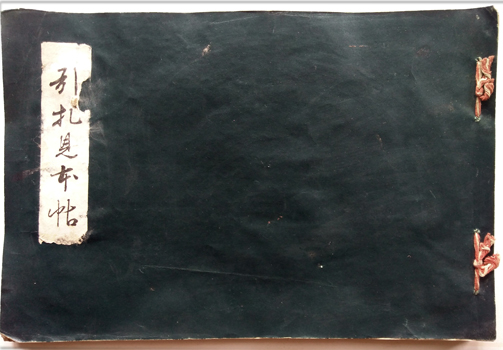
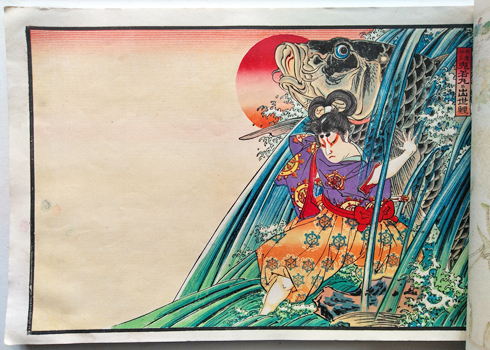
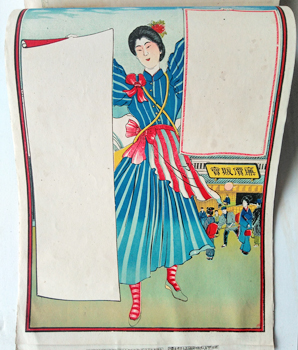


Hikifuda specimen book. [Hikifuda Mihon Jo]. Osaka c1902. 25x37cm original string tied wrappers, title label; 60 colour lithographs. Some minor signs of use, stains and blotches; a remarkably good copy. Au$5100
Now this is rare. Specimen hikifuda do float around but this is because busy fingers have dismembered every sample book they can find. I knew they once existed because I've had a few individuals, each time noting the stab holes in the margin with some indignant grief. This is complete as issued.
Hikifuda - small posters or handbills - were usually produced with the text panel blank. The customer, usually a retailer, had their own details over printed, so the same image might sell fine silk or soy sauce. The colophons that have survived the trimmer in this book date between 1899 and 1902. Each hikifuda is numbered on the back but not in any sequence. I haven't deciphered a printer's name in the colophons but I'm sure someone literate can.
From what I can see, if you wanted fine, delicate printing you went to Kyoto; if you wanted commercial publishing on a huge scale you went to Tokyo; and if you wanted brash, vivid to the point of lurid, advertising you went to Osaka. I hope other printer's albums of Osaka advertising art have and will survive the breakers but I won't be holding my breath for the next one.
The splendidly flamboyant and assertive modern young woman in stripes toward the end of the album is unlike any other I've seen from this period. A special copy (on heavier paper) of that was my first hikifuda purchase and is still my favourite. And since this album has just doubled the number I've handled, that's saying something. Another shows a hardworking young couple with the main caption 'Shiobara Tasuke' - who was a rags to riches merchant of the 18th and early 19th century. This makes sense but doesn't explain why the cheerful young woman is about to blithely put a cleaver through her kimono and/or arm while the falcon and the naval artist does explain why Japan has such a tradition of impossible bird's-eye views. There's stuff to learn here.
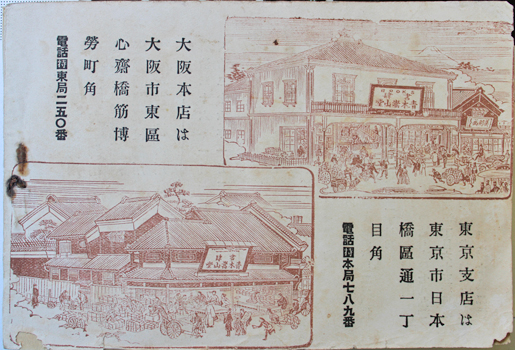
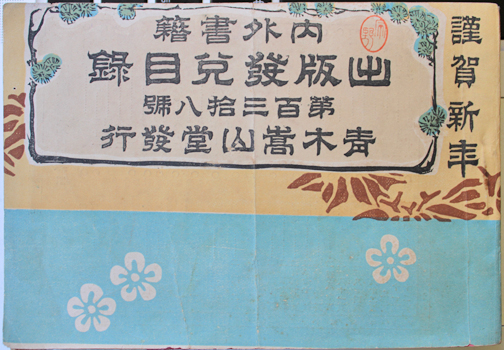
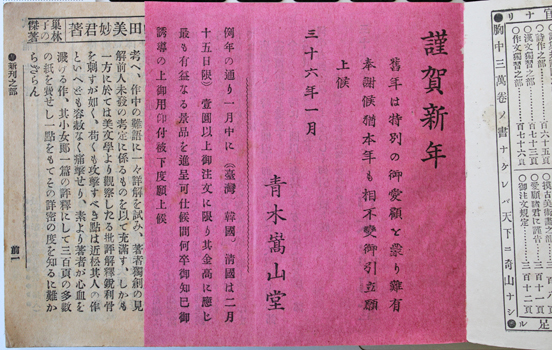


Catalogue - books. Aoki Suzando. [Naigai Shoseki Shuppan Hatsuda Mokuroku] Aoki Suzando 1903 (Meiji 36). 11x16cm publisher's colour printed wrapper; 316pp. Natural browning of the paper, an old fold; a rather good copy. Au$65
Aoki Suzando was a busy and bigtime publisher of prints and bookseller with shops in Osaka and Tokyo from the late 1870s to the early 1920s. These are illustrated on the back wrapper.
I have no idea how many thousand books are in this catalogue of domestic and foreign books but it must be a pretty good indication of what was available in late Meiji Japan.
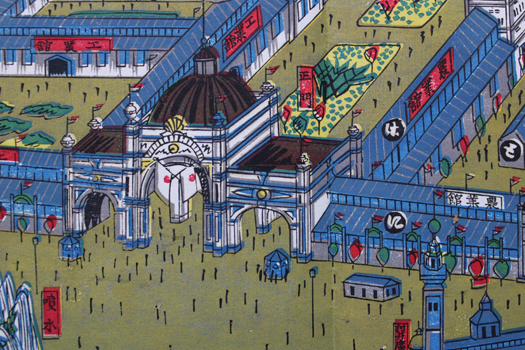
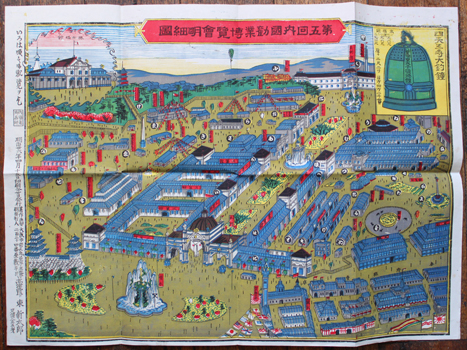
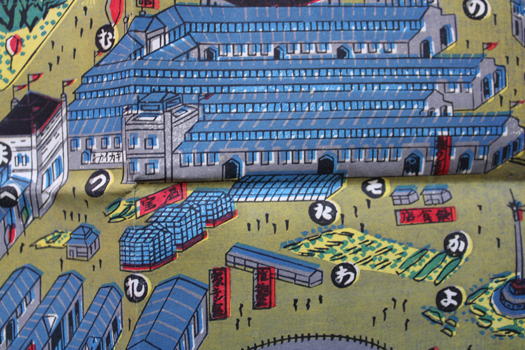
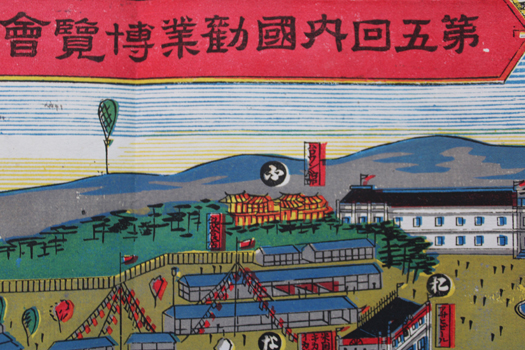

Exhibition - Osaka 1903. [Daigokai naikoku kangyo hakurankai mesaizu]. Osaka, Azuma Shintaro 1903 [Meiji 36]. Colour lithograph 40x54cm. Au$150
A robustly coloured if roughly printed bird's-eye view. The Fifth National Industrial Exhibition in Osaka in 1903, while the last of the series begun in 1877 was the largest and included a lot of firsts. It was the first with a court for foreign countries - quite a few exhibited their wares. It was the first held at night - electricity and illumination was a great feature - and the Japanese public was introduced to wireless telegraphy, American automobiles, x-rays and cinema. A sixth exhibition scheduled for 1907 was to be an international exhibition but that plan fizzled. The Tokyo exhibition of 1907 was pretty grand but not what was hoped for after 1903. It was 1970 before Japan held a true international exhibition.
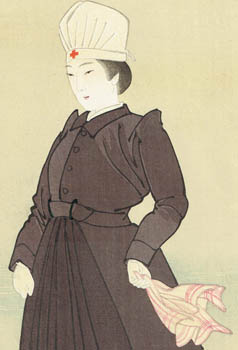
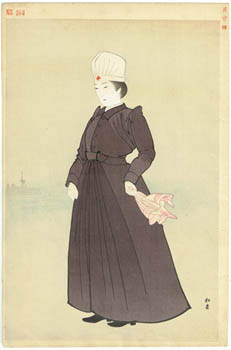

Yukawa Shodo. War Nurse from the series [Kinko Fuzoku Hyaku Bijin - 100 Beauties Past and Present]. [Osaka, Wakita Ainosuke?] c1903. Colour wood block print, 42x28cm. A little browning; with full margins. Au$375
Shodo's series is mostly dress up. He put his beauties into costume, gave them a prop or two, maybe a hint of background. And the majority are decorative and little more. But here and there are exceptions. A weaver hold us with her confident gaze, gripping her shuttle like a club, and a couple of his modern women are truly modern rather than mannequins put into trousers. A young student in hakama - men's wide trousers - reading while she leans against the window has the true defiant insouciance of a young woman going places and this nurse is nothing less than majestic with her implacable calm. This is a woman with a job to do. This is not a woman to be ordered about.
Most but not all prints I've seen from this series have the red numbers in Arabic and Japanese at the top which don't relate to the print's place in the series. Is this that French invention - a numbered limited edition? I've seen numbers up to about 130. Some also have a caption in the bottom margin; those I've seen have been both numbered and unnumbered.
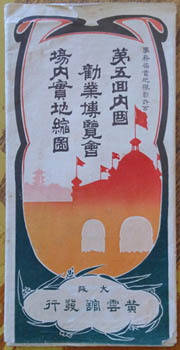
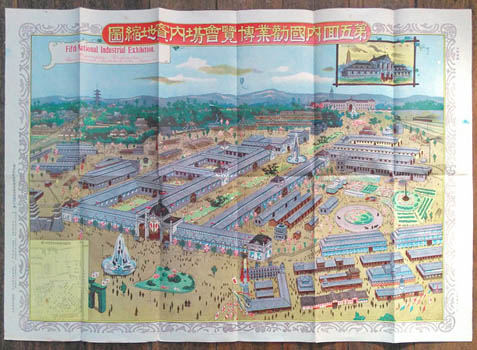
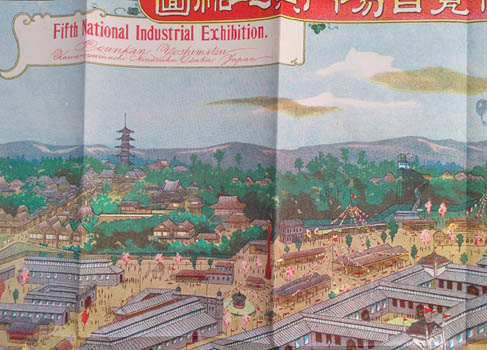
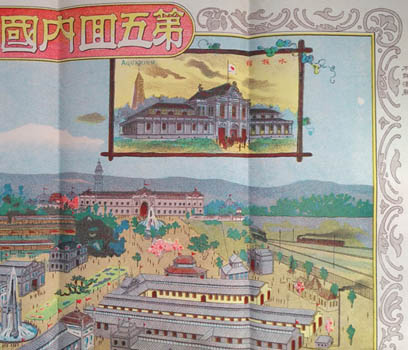

Exhibition - Osaka 1903. [Daigokai naikoku kangyo hakurankai jonai jitchi shukuzu]. Fifth National Industrial Exhibition ... Osaka. Osaka 1903 (Meiji 36). Colour lithograph 55x79cm; folded as issued. A couple of smudges and spots; a rather good copy with its original colour illustrated outer wrapper, Au$300
A pretty good bird's-eye view. The Fifth National Industrial Exhibition in Osaka in 1903, while the last of the series begun in 1877 was the largest and included a lot of firsts. It was the first with a court for foreign countries - quite a few exhibited their wares. It was the first held at night - electricity and illumination was a great feature - and the Japanese public was introduced to wireless telegraphy, American automobiles, x-rays and cinema. A sixth exhibition scheduled for 1907 was to be an international exhibition but that plan fizzled. The Tokyo exhibition of 1907 was pretty grand but not what was hoped for after 1903. It was 1970 before Japan held an international exhibition.
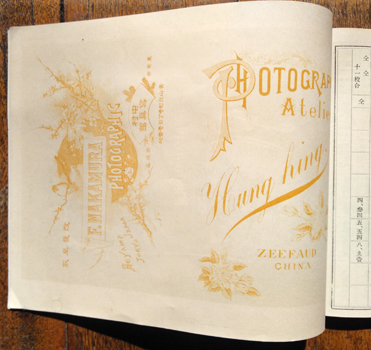
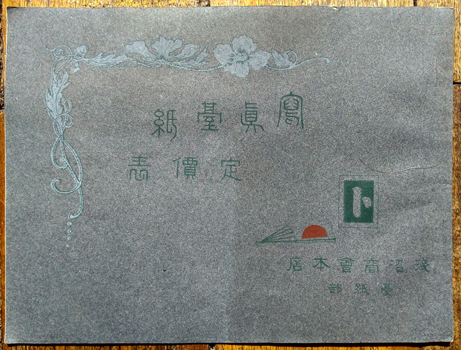
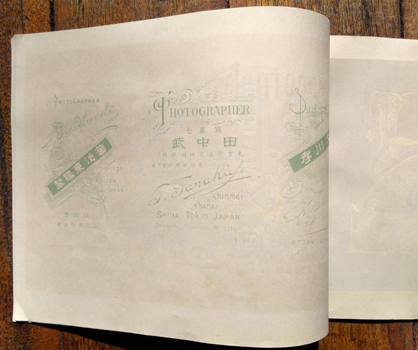
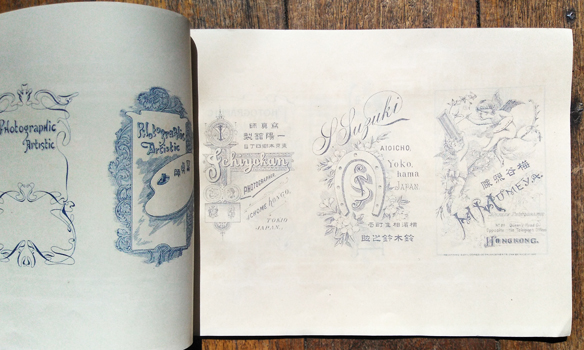

Catalogue - printed photograph mounts. Asanuma Shokai. [Shashin Daishi Teika-hyo]. n.p. Asanuma Shokai 1903 (Meiji 36). 18x23cm publisher's decorated wrapper; [8]pp and 12 pages of illustrated examples in various monochromes. A nice copy. Au$500
A mountain of printed and most decorative mounts for studio photographs were produced but this is the first catalogue of them I've seen. Most of these appear to be actual examples produced for photographers in Japan, Hong Kong, China and maybe Manchuria - judging by the Russian type. As an example of maybe a dim corner of photographic history - I don't know enough to judge - this is pretty good, but as an example of a dark corner of graphic design and commercial printing this is fabulous.
The last plate is an array of decorative borders.
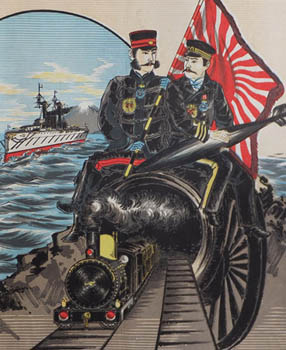
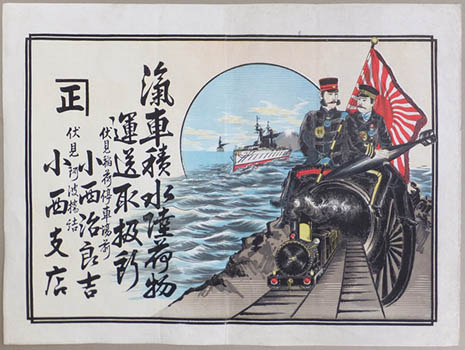

Hikifuda. [Kisha Seki Suiriku Nimotsu Unso Toriatsukaijo]. n.p. [c1904]. Colour lithograph 37x52cm. Old folds. Au$300
Freudians, symbolists and students of gay innuendo of the last century, eat your hearts out. Our artist beat you to every punch by years. The train may have left the cannon but the banner and torpedo suggest that another could be along soon.
This patriotic hikifuda - large handbill or small poster - advertising a transport company must date to the Russo-Japanese war.

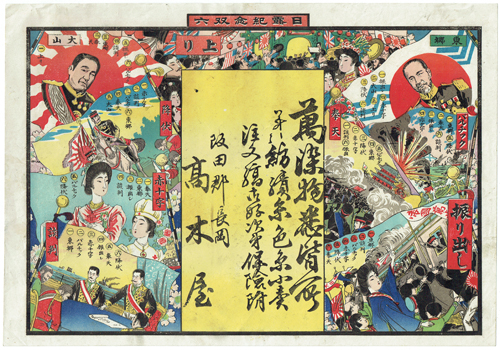
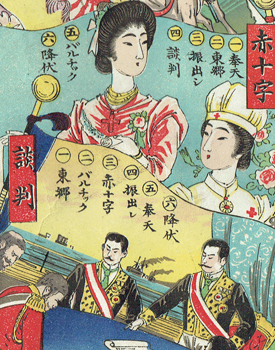
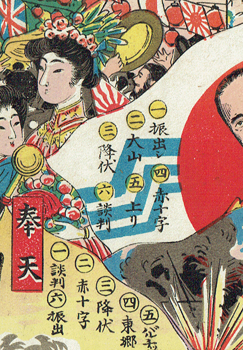

Hikifuda & Sugoroku. [Nichiro Kinen Sugoroku]. n.p. [1905?]. Colour lithograph 26x37cm. A bit smudged and rumpled, pretty good. Au$300
I have seen a few hikifuda made as sugoroku but they have been staid affairs featuring birds, flowers and graceful women in flowing kimonos. This exuberant advertisement game celebrates the Russo-Japanese war victory.
These hikifuda - small posters or handbills - were usually produced with the text panel blank. The customer, usually a retailer, had their own details over printed.
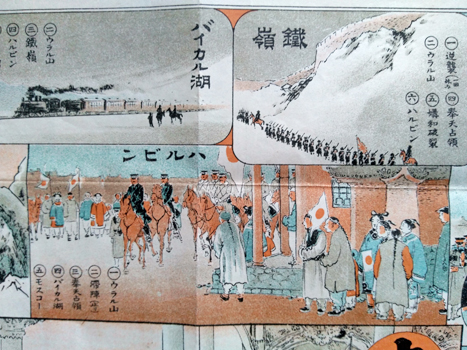
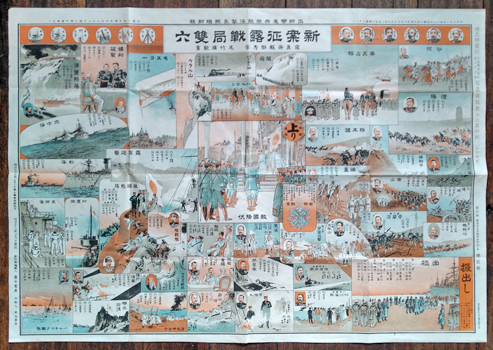
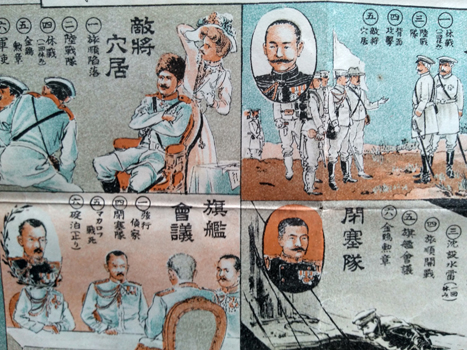
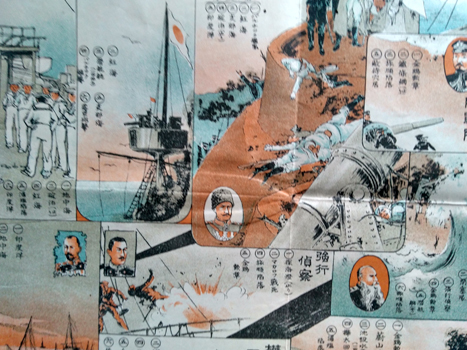

Otake Kokkan. [Shin'an Sei-Ro Senkyoku Sugoroku]. Tokyo, Hakubunkan 1905 (Meiji 38). Colour broadside 55x79cm. A few pinholes; rather good. Au$300
The new year gift from the magazine Shashin Gaho. This may be muted and delicate at first glance but there is plenty of turmoil on land and sea. And it looks to me you could learn all you really need to know about the Russo-Japanese war. There's a lot packed in.
Otake was a well regarded, prize winning, Nihonga painter who was firm about maintaining Japanese tradition but like many such artists was a busy producer of prints and illustrator of magazines, books and advertisements.
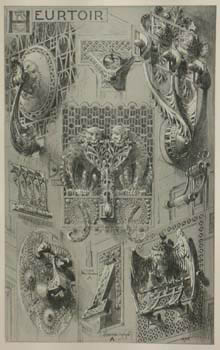
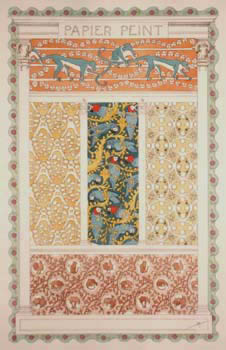
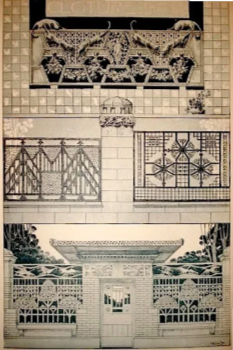
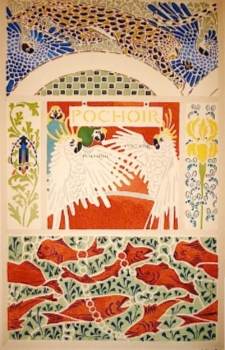

BINET, Rene. Esquisses Decoratives. Paris, Librairie Centrale des Beaux-Arts [c1905]. Folio, loose as issued in four fascicules in illustrated wrappers, all in publisher's portfolio of cloth backed illustrated boards; [2],14pp and 60 plates, 13 pochoir and a few others with a second colour added, b/w illustrations through the text. A rather good copy. Au$1600
Binet, like many architects and designers, followed Haeckel into the microscopic world for grotesque and fantastic inspiration but married such modernity with historicism in a singular way. Durant (in 'Ornament') calls Binet 'in many respects the typical French Art Nouveau designer' which, apart from being too dismissive, is just not right. Many of his designs, particularly the coloured graphics, are ultra modern high art nouveau but much of his work has an oddly arcane, recherche effect - in which something as modern as an electric light switch modelled on the forms of diatomes or radiolaria and treated with Beaux Arts tradition becomes a mysterious if not menacing almost gothic artifact. Without claiming anything of the same stature, or even similar results, for Binet he could probably be more usefully likened to Gaudi. This is an exposition of ideas for every school of design that Binet could encompass - from architectural detail to pochoir graphics; shop fronts to tapestry; stained glass to gardens; jewellery to mosaics.
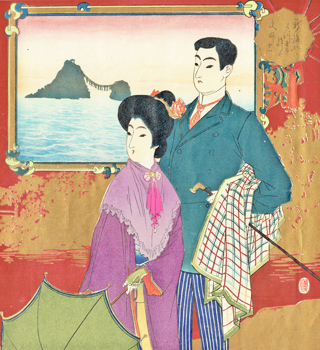


Hikifuda. [Wata Neru Zakka-Sho]. 1906 (Meiji 39). Colour lithograph 38x26cm. Au$135
I'm sure this insufferable couple are appalled to find they are advertising cotton, nails and general merchandise. I suspect that picture behind them is the view through their stateroom window. They must have thought they would showcase luxury travel and travel goods.
Hikifuda - small posters or handbills - were usually produced with the text panel blank. The customer, usually a retailer, had their own details over printed, so the same image might sell fine silk or soy sauce.
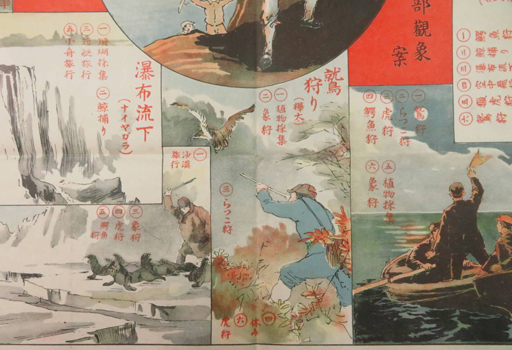
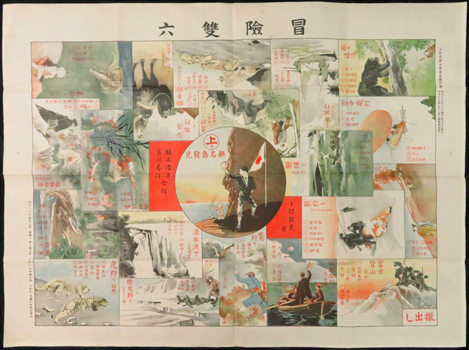
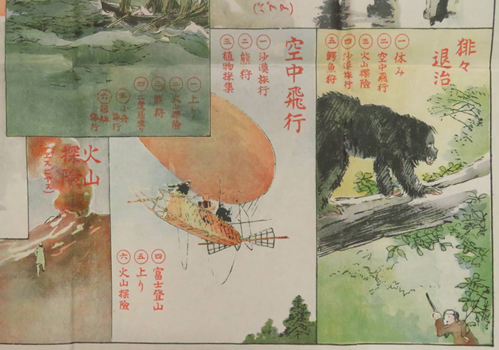
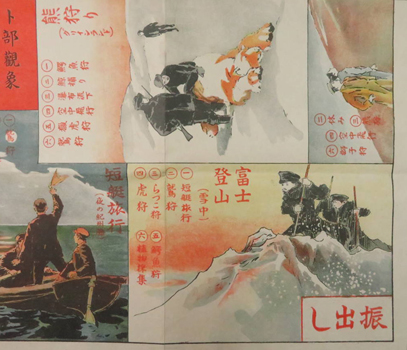

Kaburagi Kiyokata & Miyagawa Haru? [Boken Sugoroku]. Shonenkai 1906 (Meiji 39). Colour broadside 47x63cm. Folded as issued, rather good. Au$300
Don't be fooled by the elegant and delicate artwork. This new year gift from the boy's magazine Shonenkai is filled with adventure, peril and slaughter. Nothing with fur, fin or feather - if large enough - is safe from these boys on their jaunt round the world. When they aren't shooting eagles they are clubbing seals.
No artist is named but a 2016 exhibition at the Shinjuku Historical Museum attributed this game to Kaburagi and Miyagawa.
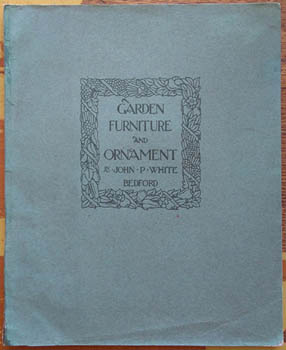
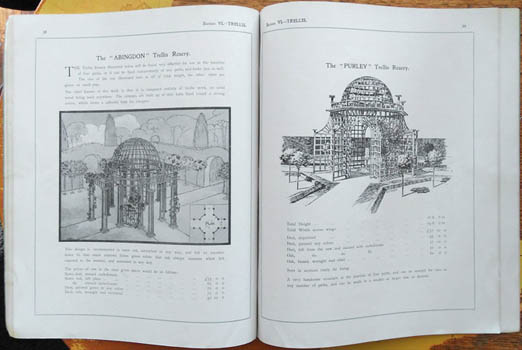
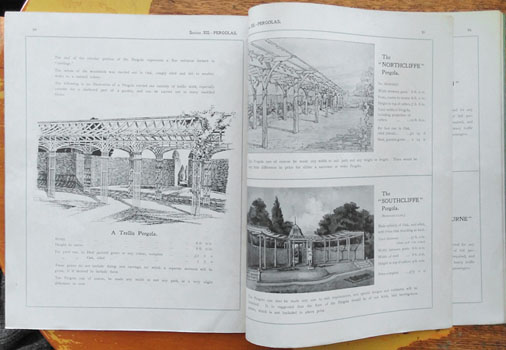

Catalogue - Garden Furniture. John P. White, Bedford. A Complete Catalogue of Garden Furniture and Garden Ornament. By John P. White, The Pyghtle Works, Bedford ... Xmas, 1906. Bedford 1906. Quarto publisher's printed wrapper (a missing piece from the back wrapper expertly replaced); 112pp illustrated in line and photo throughout. A couple of related flyers loosely inserted, quite a good copy. Au$875
From pots to bridges and greenhouses; an extensive range, essential for the chic but thoroughly English - ie Arts & Crafts - garden. White made furniture designed by Baillie Scott and some of this stuff may well be his but the designs here are, with two exceptions, uncredited except by inference from a passing remark to White himself. The two credited are by The Hon. Mrs. Anstruther. You don't withold credit from someone like her.
Many of the drawings are signed and while it isn't clear that the artist was also the designer those signed 'J.C.' are likely by James Crossland who designed furniture for White at about this time.
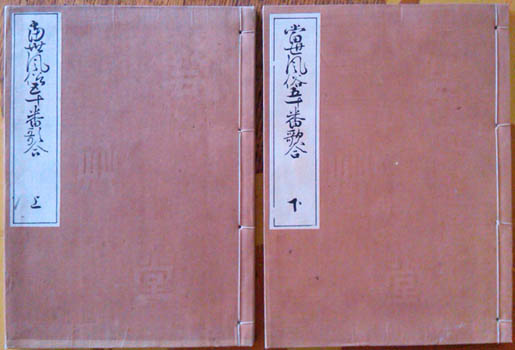
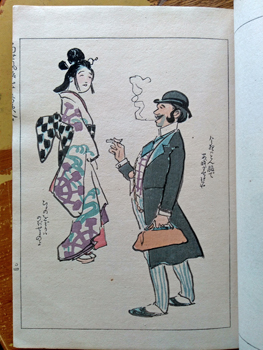

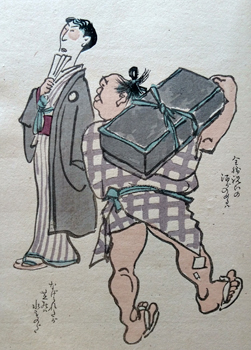

Asai Chu. [Tosei Fuzoku Gojuban Utaawase]. Tokyo, Yoshikawa Hanschichi 1907 (Meiji 40). Two volumes 25x18cm publisher's wrapper with title labels; 52 full page colour woodcuts by Asai. An outstanding pair. Au$1500
Such a fresh and crisp copy of the original edition that I can't bring myself to flatten these out enough to photograph the interior. So the illustrations here, apart from the covers, are from another copy, almost as good, to give an idea of the charm and humour of Asai's observations of the modern Japanese seen in pairs but not necessarily couples. Each of these illustrations accompanies a poem on modern customs; the book's title calls this a poetry competition.
Asai, elder and teacher of the school of western painting, fortunately never abandoned the tradition of satirical illustration. This was published just before his death. Each of these illustrations accompanies a poem on modern customs; the book's title calls this a poetry competition.

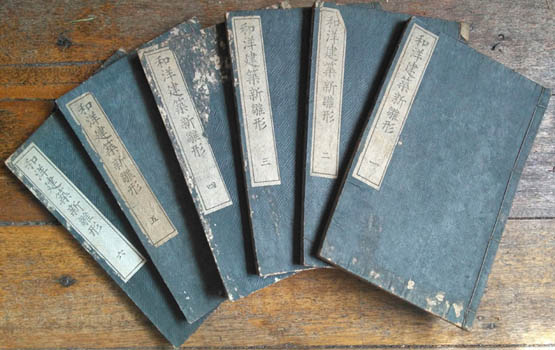
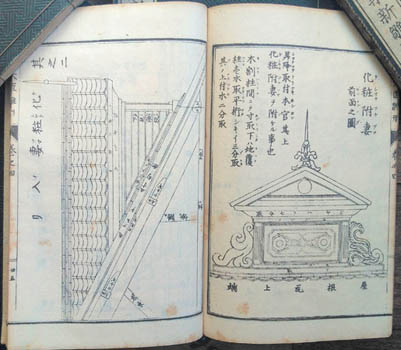
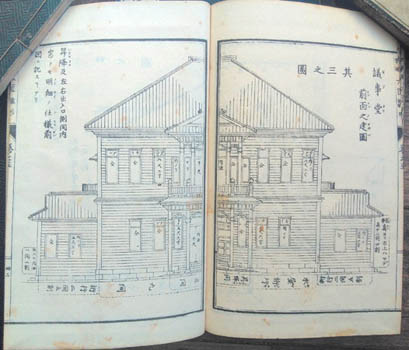

Kameda Yoshiro (or Kichirobei). [Wayo Kenchiku Shin Hinagata]. Osaka, Seikado 1907 (Meiji 40). Six volumes 22x15cm, publisher's wrappers with title labels; illustrated throughout with plans, elevations, measured drawings etc. Wrappers with some surface rubbing or insect grazing; a pretty good set. Au$850
I'm not sure whether this should be described as Japanese principles applied to western design or the other way round. I think both, if it matters. An excellent builder's pattern book that was certainly put to wide use.
There is a 2008 learned paper by Yanigasawa and Mizoguchi that shows how Kameda introduced Japanese carpentry and the modular system into western design but all except the precis of their paper is in Japanese so I have no idea how they go about proving their point. They do tell us that Kameda was a master carpenter in Fukuoka.
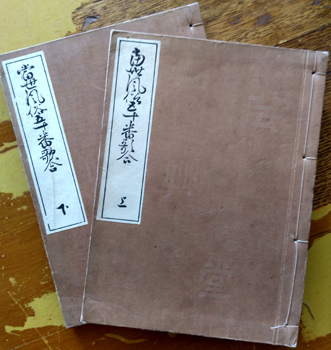




Asai Chu. [Tosei Fuzoku Gojuban Utaawase]. Tokyo, Yoshikawa Hanschichi 1907 (Meiji 40). Two volumes 25x18cm publisher's wrapper with title labels; 52 full page colour woodcuts by Asai. A couple of bits of stitching broken, still an outstanding pair: fresh, crisp, beautifully printed. Au$850
First edition of this captivating collection of portraits of couples, if only momentarily. Each of these illustrations accompanies a poem on modern customs; the book's title calls this a poetry competition.
Asai, elder and teacher of the school of western painting, fortunately never abandoned the tradition of satirical illustration - though there is more good natured but pointed humour here than harsh satire. This was published just before his death.
  1 [2] 3 4 5 1 [2] 3 4 5   |